Daily News
The MSI Raider GE77 is the kind of laptop that would have found a happy home in the previous decade, when gaming portables were huge, hulking beasts with bold designs and desktop-style components.
MSI’s latest notebook certainly harkens back to those days, but underneath the hood it’s far more modern. It’s powered by a top-tier GeForce RTX 3080 Ti laptop GPU and a Core i9-12900HX, one of the fastest mobile CPUs that Intel has ever designed – and its 17.3″ display deploys a high resolution and rapid refresh rate. On paper, there’s lots to like about this laptop – but you’re going to need plenty of paper to pay for it, too. The rig we’ve reviewed (GE77HX 12UHS-082 model) costs a whopping $3,699.
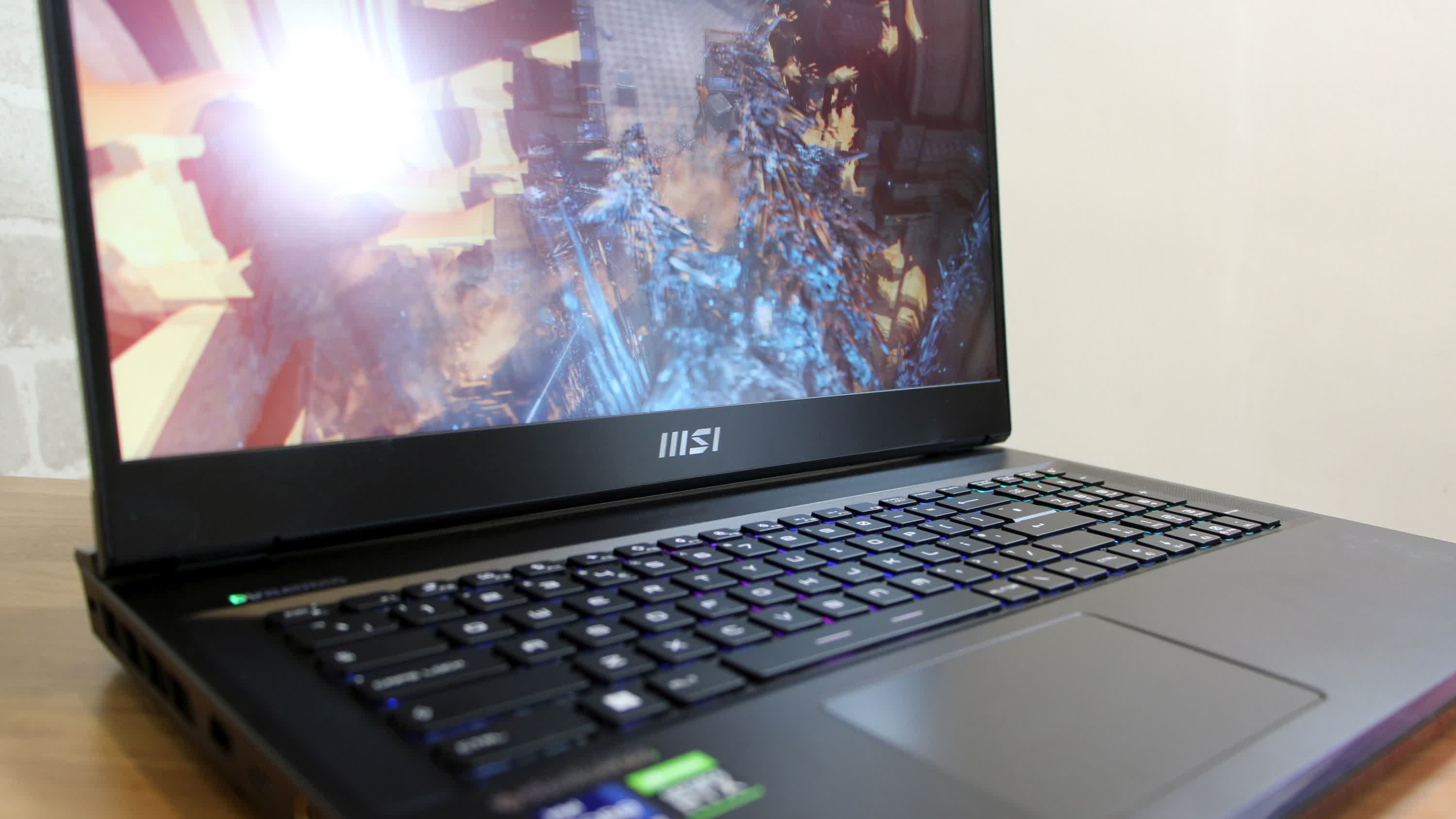
MSI certainly isn’t the only company that produces 17.3″ notebooks with eye-watering prices, though. Configure an Alienware x17 R2 with a specification that closely mirrors the MSI and it’ll cost $3,999. The sleeker Razer Blade 17’s RTX 3080 Ti rigs cost at least $4,000, too.
Features and Design
The MSI Raider GE77 is a great purchase for anyone who misses the glory days of big, bold gaming hardware. The front edge of the chassis is dominated by a wide strip of RGB LEDs that uses 30 zones to provide smooth color changes, and the lid has huge MSI lettering and a glowing logo.
Spin the Raider around and you’ll find aggressive angles and huge air vents, and even the underside is adorned with an MSI Raider logo and a stylized, MSI-branded rubber pad.
The GE77 is bolder than either rival. But while some will prefer that, its eye-catching aesthetic won’t suit everyone. The Alienware x17 R2 is striking, but its white-and-black design is more mature. The Razer Blade’s all-black, aluminum casing is more subtle when compared to the MSI, too.
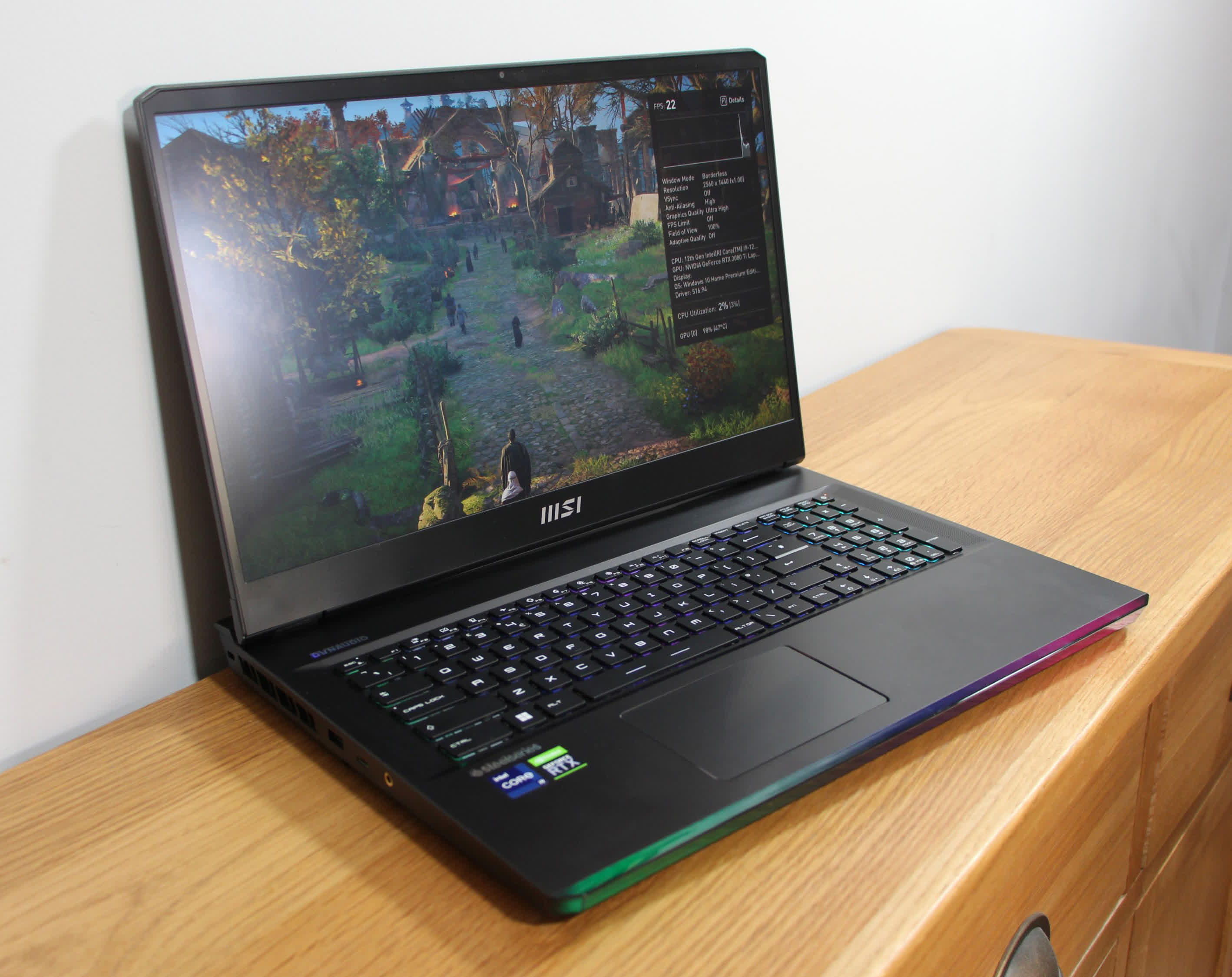
Internal access is pretty easy on the GE77 – the base is secured with lots of screws, but they’re large, standard Philips screws so you don’t need extra tools. Once you’re in, there’s plenty of room to work: both SO-DIMM slots are accessible and there’s a spare NVMe socket alongside the existing SSD. The wireless chip is easy to reach for connectivity upgrades, and the cooling hardware and battery are similarly approachable.
The Alienware’s base panel is just as easy to remove, but the Razer takes a step back here. You’ll need a T5 screwdriver. And while its memory and SSD slots are easy to reach, the cooling hardware isn’t as accessible.
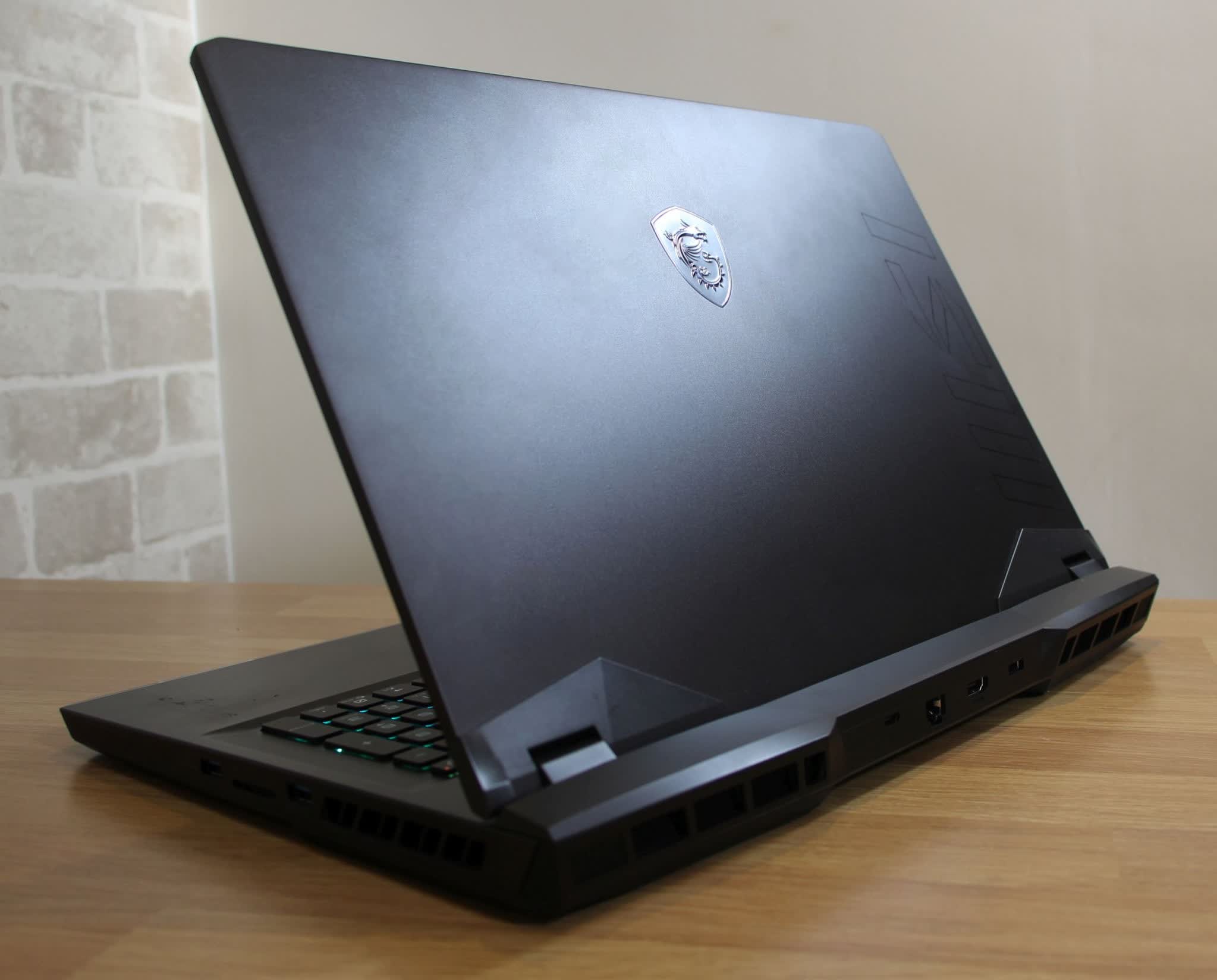
There’s one major design department where the MSI Raider falls behind the competition: size. The MSI weighs 6.6 pounds and its power brick adds 2.6 pounds more. At its slimmest point, the Raider is still 25mm thick – at its largest, that figure extends to 40mm.
The Raider’s rivals are more manageable. The Alienware also weighs 6.6 pounds, but its power brick tops out at 1.9 pounds and it’s only 21mm thick. The Razer and its power brick tip the scales at 7.6 pounds and it’s 20mm thick.
The Display
At least you’re getting a display with a decent specification inside this hulking notebook. The 17.3″ panel combines a 2,560 x 1,440 resolution with a 240Hz refresh rate – balanced figures that allow for crisp single-player gaming and decent pace in esports titles. The 3ms response time is another good figure for competitive gaming.
It’s a solid mainstream specification, and the MSI bolstered its design with decent performance. The contrast ratio of 1,197:1 is a good IPS figure and ensures that the screen has solid levels of vibrancy, and the Delta E of 1.32 means that colors are accurate. The color temperature of 6,608K is superb, too.

MSI’s screen renders 99.7% of the sRGB gamut at 138.6% volume, which is a great result that ensures an impressive amount of punch in every color needed by games. Those figures are near-identical to the Alienware.
The maximum brightness level of 359cd/m2 is ample for indoor use, but it’s not high enough to tackle bright outdoors. The Gamma average of 1.93 is no disaster, but it should be closer to 2.2 and leaves darker areas lacking some depth and gradation.
Despite that gamma result, games look excellent – there’s enough contrast and sRGB volume to render mainstream titles with punch, and the screen accurately produces every shade needed. Combine that with the size, resolution and refresh rate and you’re going to have an absorbing and immersive time. There’s little to choose between the MSI and rival displays, although Razer’s screen is much better.
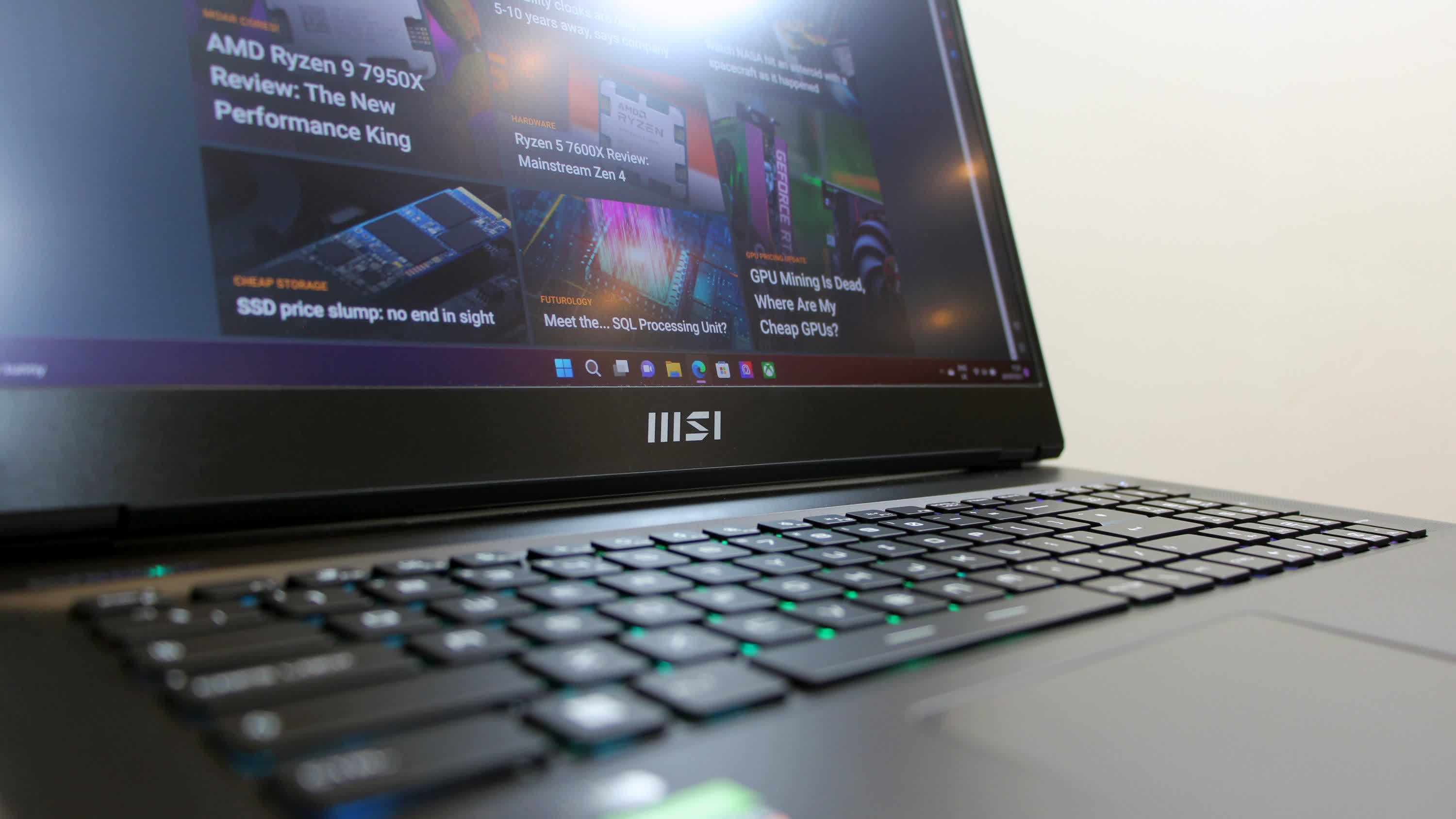
Go beyond games, though, and the GE77’s screen is more ordinary. Its DCI-P3 coverage level of 96.6% is good, but its relatively poor peak brightness figure means it’s not suitable for HDR games and media. Its 81.4% Adobe RGB coverage level isn’t high enough to allow for working in that more demanding gamut, and both rivals are better.
The Alienware and Razer laptops also offer more versatility when it comes to alternative choices. Match the Alienware’s specification with the MSI and you can get either a 4K/120Hz panel or a 1080p 480Hz display for $3,999 – the former is sharper in single-player games and the latter is amazing for esports.
And at the time of writing, a top-notch esports panel with a 360Hz refresh rate and 1ms response time costs just $3,099, although we expect that price to rise. Alienware’s displays also have G-Sync, which is absent from MSI and Razer rigs.

Razer’s RTX 3080 Ti laptop isn’t available with a 2,560 x 1,440 screen, but its $3,999 model includes a 1080p panel at 360Hz and for $4,299 you’ll get a 4K display at 144Hz. The former option improves on the MSI for esports, while the latter also delivers more single-player sharpness.
Look elsewhere if you want fine control in color-sensitive workloads, too. The MSI Center tool is decent and gives you plenty of options for customizing the GE77, including overclocking, but the MSI True Color module suffers from bugs that hinder its color profiles. The bugs are caused by conflicts between the software and Intel’s integrated graphics drivers, and current workarounds are complex and inconsistent – so hopefully MSI supplies a better solution soon.
Input and Connectivity
MSI’s machine ticks the right boxes in many practical departments. Build quality is exceptional – there’s no give in the aluminum panels or seams, and we’d throw this laptop into a bag with confidence that it’s not going to suffer any damage.
The large chassis also allows MSI to offer plenty of connectivity. The left-hand edge has individual USB 3.2 Gen 2 Type-A and Type-C ports, with the latter also tackling DisplayPort but not power delivery.
The right-hand side has two more USB 3.2 Gen 1 sockets and an SD card reader. Along the back edge there’s a Thunderbolt 4 connector that offers DisplayPort compatibility and 5V/3A device charging. There’s a 2.5Gbps Ethernet output and an HDMI 2.1 port that allows 4K/120Hz and 8K/60Hz playback.
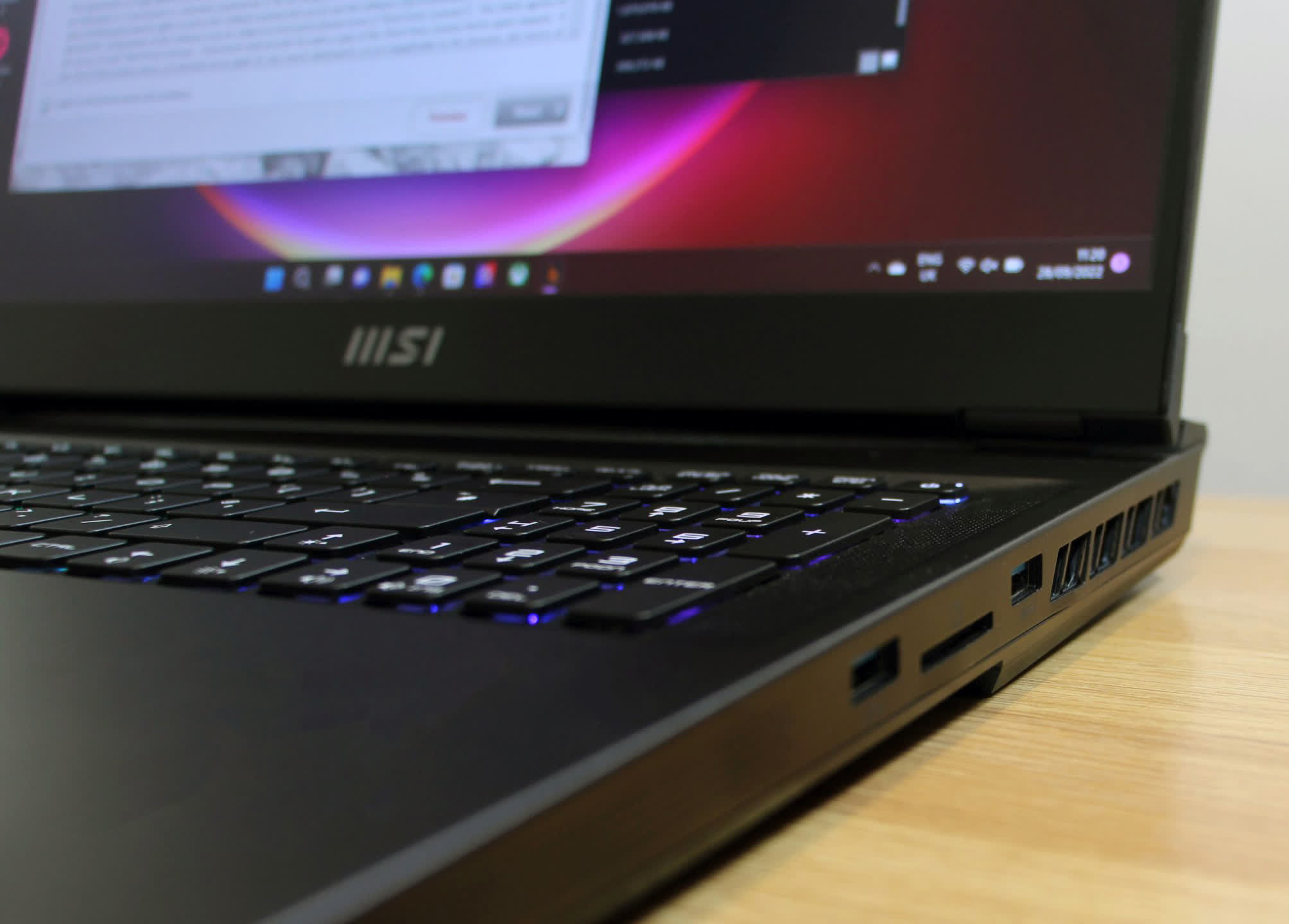
It’s an impressive array of ports. Internally there’s dual-band 802.11ax wireless that’s pre-certified for Wi-Fi 6E and Bluetooth 5.2. The webcam is a 1080p model that delivers crisp, bold imagery. The webcam doesn’t support Windows Hello sign-in unfortunately and there’s no fingerprint reader – biometric login is the only big feature missing from this laptop.
The Alienware is similar when it comes to connectivity and features – it adds Windows Hello to its webcam, but only has a microSD card slot. Razer’s rig is the winner, though: it includes an SD slot, biometric login and more Thunderbolt and USB connectivity than the MSI and Alienware notebooks.
MSI’s gaming laptops have been sporting SteelSeries keyboards for some time, and there’s a reason why MSI relies on the experts. The buttons are fast, crisp and bouncy, so it’s easy to get up to speed during frantic gaming sessions – and their reliable movement means you can rely on the buttons to not lead you astray in busy moment.
The keyboard has per-key RGB LED backlighting, too, and includes a number pad. The function row has buttons to alter fan speed and open the MSI Center control app, and users can also deploy shortcuts to load a crosshair or the SteelSeries GG tool, which is used for customizing the lighting and recording macros. Smartly, pressing the keyboard’s Function button turns off most of the lights to leave the Function row highlighted.
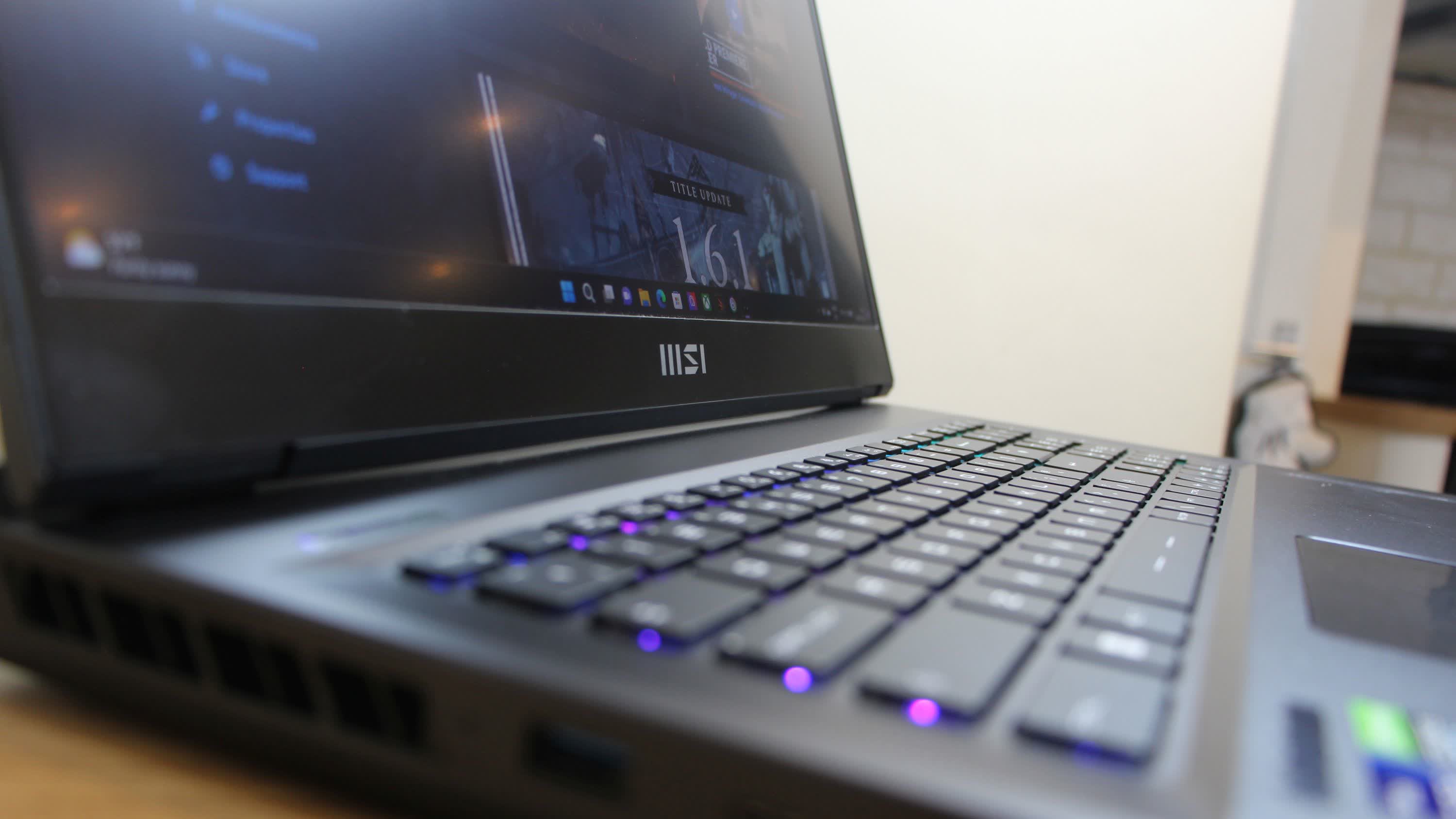
The keyboard only has minor layout issues. The Return key is small considering the size of this rig, and the Power button sits on the keyboard itself – so it might be subject to accidental hits. The cursor keys aren’t set apart from the rest of the buttons, and the number pad is a little narrow. The Function key is on the right, rather than the left.
None of these are big problems, though, especially as anyone who buys this machine will only need a little time to become familiar with the layout quirks. The MSI’s typing gear compares well with rivals, too: the Razer doesn’t have a number pad and its button-presses aren’t as satisfying. The Alienware doesn’t have a number pad, either, and you’ll only get a more robust experience if you pay $50 for the Cherry MX keyboard upgrade.
The trackpad doesn’t keep pace with the typing gear. It’s small and its buttons are weak – and is only suitable for everyday, casual use rather than any sort of gameplay. That’s no surprise when anyone buying a pricey gaming notebook will connect a USB mouse instead.
Performance
MSI has gone right to the top of Nvidia and Intel’s stacks to find the hardware for the Raider GE77. The GeForce RTX 3080 Ti (read our full review) operates at its peak power limit of 175W in this laptop – a big envelope for its 16GB of memory and 7,424 stream processors to access.
Intel’s Core i9-12900HX is one of the beefiest mobile chips around, with 8 Hyper-Threaded P-Cores, 8 E-cores and a top Turbo pace of 5 GHz. It’s got a mighty TDP of 157W, too, which outstrips the 115W peaks used on the i9-12900H and i9-12900HK you’ll find elsewhere. This meatier Core i9 part also has larger L2 and L3 caches when compared to other Core i9 CPUs.
The rest of the specification is typical of a high-end gaming laptop.
There’s 32GB of dual-channel DDR5 clocked to 4800MHz and a 1TB Samsung PM9A1 PCIe 4.0 SSD with read and write speeds of 7,085MB/s and 5,141MB/s. That’s great pace, although keen gamers would have preferred more storage.
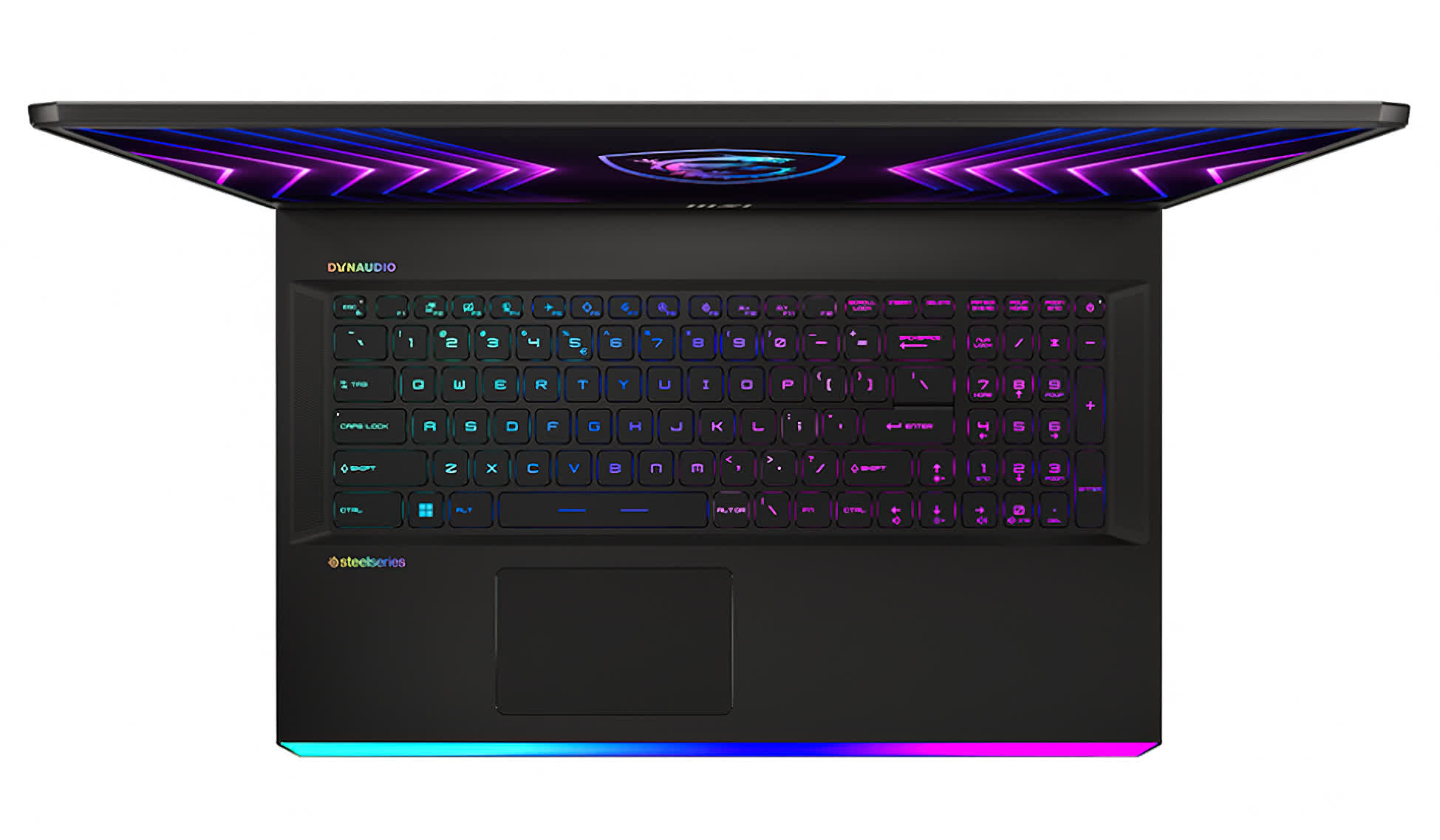
There’s no shortage of gaming power on offer. At the MSI’s native resolution of 2560 x 1400 you’ll be able to play anything: it returned minimum and average frame rates of 42 fps and 73 fps in Assassin’s Creed Valhalla at Very High settings and ran through Red Dead Redemption 2’s High settings at 63.4 fps and 84.1 fps. Both results are a little faster than the RTX 3080 Ti in our review.
The hits keep on coming. In Far Cry: New Dawn the MSI averaged 116 fps with every graphics setting at maximum, and it delivered triple-figure averages in Borderlands 3. In Rainbow Six Siege it averaged 242 fps at top settings, so there’s ample pace for playing esports games at the 240Hz refresh rate.
It’s tremendous performance. You might have to reduce graphics settings if you want 60 fps minimums in tough games, but excellent average framerate figures mean you won’t hit that issue too often. You’ve got the ability here to output at 4K and onto VR headsets, and DLSS and ray tracing is no problem.

Look at the 1080p results and you’ll see that the MSI compares well to the Alienware. The GE77’s Assassin’s Creed average of 94 fps beat the x17 by five frames, and its Red Dead 2 average of 103.43 fps was marginally faster. MSI’s rig will also outpace the Razer Blade 17, which has a lower power limit of 165W.
Not everyone needs an RTX 3080 Ti, though. The RTX 3070 Ti will play today’s big-name games at 60 fps averages using the MSI’s native resolution – and it won’t struggle with esports games either.
Search for GE77HX 12UHS-004 and you’ll find the RTX 3070 Ti model. It costs $2,499, so it’s far cheaper than the RTX 3080 Ti rig, and it also includes an i7-12800HX processor that remains very fast alongside 16GB of memory and a 1TB SSD – and the same 1440p/240Hz display. That’s a good price: an equivalent Alienware costs $2,899, and a Razer arrives at $3,199.
The graphics core doesn’t disappoint – and the processor isn’t sluggish either. In Cinebench R23’s single- and multi-core tests the i9-12900HX zipped through with scores of 1,900 and 21,256. The former score is about level with the lower-power i9-12900HK, while the latter is about 5,000 points ahead. That’s a huge gap, and it’s especially stark when you remember that the i9-12900HK is the top CPU choice inside the Alienware. The Razer, which peaks with an i9-12900H, is a little further back.
The i9-12900HX scored 0.91s in Matlab, which is about half a second better than conventional Core i9 chips, and its Excel result of 6.07s also led the way. Its PCMark 10 Applications result of 15,584 was great, although not markedly different from other Core i7 and i9 CPUs.
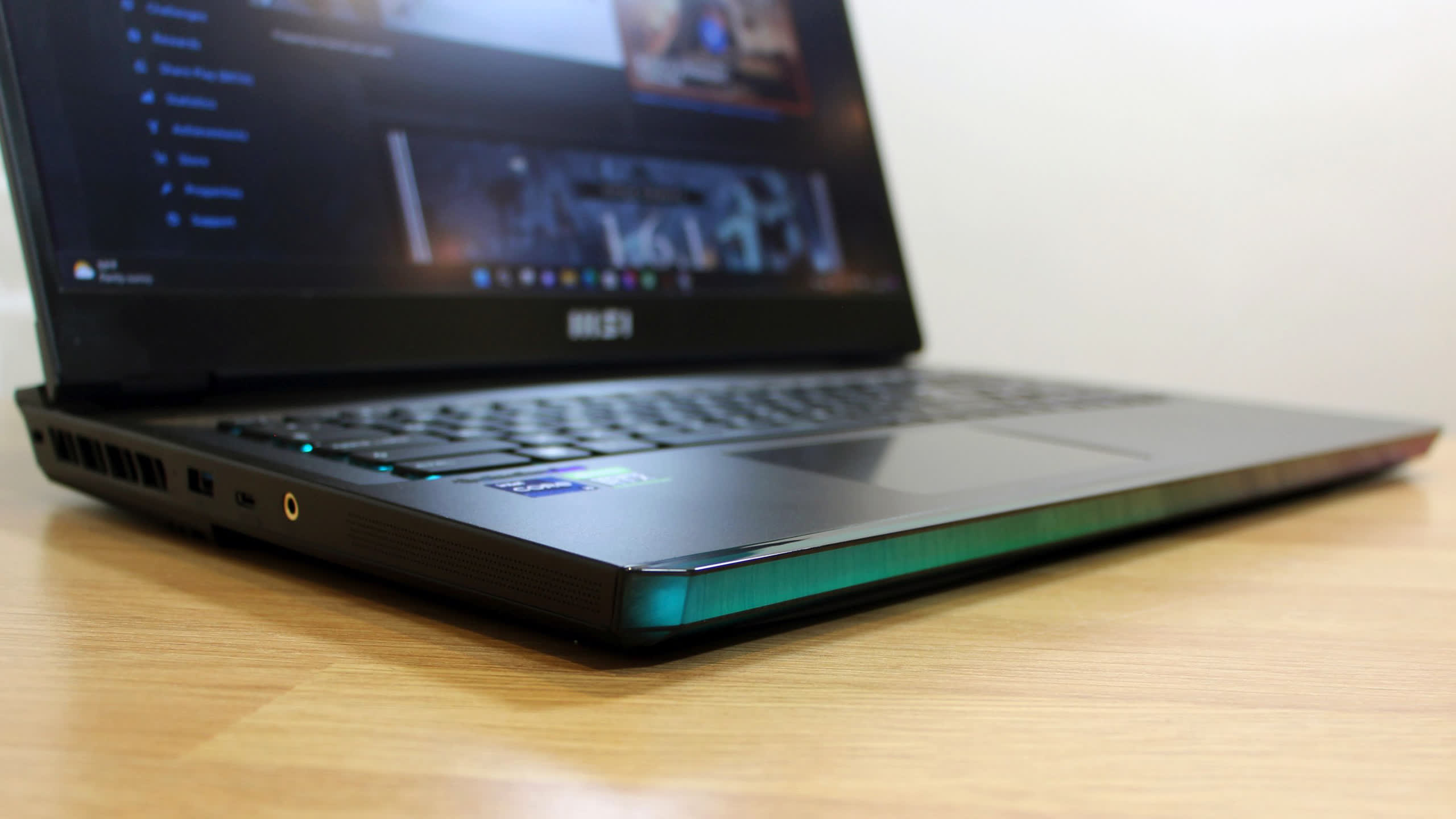
The only area where the GE77 didn’t dominate was in 7-Zip. Its compression pace of 79MB/s crept ahead of the competition, while its decompression score of 962.5MB/s fell slightly behind – but, even then, that’s hardly slow.
There is, quite simply, almost nothing that the GE77 can’t do. It’ll handle the toughest content creation tasks, from batch photo-processing to 4K video editing, and it’ll scythe through code compilation, 3D rendering and CAD software. Multi-tasking will never be an issue. You’ll only need more CPU power to tackle the toughest computing tasks, and if you’re in that position then you should be buying a desktop workstation anyway.
It’s worth considering the other side of the situation, too: while the i9-12900HX is enormously powerful, most people just won’t need this amount of grunt. If you need a laptop for content creation and work alongside games then the conventional Core i9 chips inside the Alienware and Razer rigs will get the job done in most situations and you’ll benefit from the slicker designs of those laptops.
There are other GE77 options, too. We’ve already mentioned the i7-12800HX/RTX 3070 Ti model that costs $2,595 – that rig will handle almost every task aside from the most demanding creative tools. And if you want to retain the RTX 3080 Ti, the GE77HX 12UHS-074 combines that GPU with the i7-12800HX and a 1080p/360Hz screen for $2,799. An equivalent Alienware x17 costs $3,549 and a Razer is €3,999, so the MSI GE77 still offers relatively decent value.
Thermals and Battery Life
The MSI carries top-tier hardware, but its sheer size means that it does a decent job in a surprising number of thermal situations. If you run mainstream games or work tools then the fan noise is noticeable but not intrusive and the exterior panels only warm a little.
The fans hardly spin up if you run less-demanding processing tasks. There’s not much fan output in casual games and many esports titles, too, which can make long gaming sessions comfortable.

MSI’s machine isn’t quite as subtle if you demand more from the hardware. If you really push this rig with the most challenging games or top-end creative tools then the sound levels easily top 55db. That output is louder than both rivals: the Razer is the quietest of the three when running tough software, and the Alienware is a bit more subtle, too.
External heat levels are mixed. The underside of the laptop remains cool throughout most tests, and the metal above the keyboard became hot – but never too bad. Warm air is pumped from both sides of the machine, though, which could prove uncomfortable if you’re using an external mouse.
These thermal results are mostly fine, especially given the hardware inside this laptop – but the Razer Blade 17 is quieter, and the Alienware does a better job of keeping temperatures down.
And, amazingly, the GE77 doesn’t have awful battery life. You may have to play with reduced GPU power if you game using the MSI’s 99.9Wh power pack, but in a gaming test the Raider GE77 lasted for 1 hour and 44 minutes – an hour beyond the Alienware and 30 minutes longer than the Razer could manage.
As ever, you won’t get a brilliant gaming experience if you load up the latest titles without power from the wall – but the MSI at least has more scope for mobile play than either rival. Expect this sort of lifespan in high-end work situations, too.
In a modest work test with the screen at 50% brightness the MSI lasted for 4 hours and 35 minutes, and it lost 45 minutes of longevity with the display brightness at maximum. That’s still better than the Alienware and Razer laptops, which couldn’t get within an hour.
When playing movies the GE77 lasted for nearly 8 hours with the screen brightness reduced and more than 6 with the display ramped up, so you’ve clearly got enough lifespan to watch a few TV episodes or a couple of films.
Wrap Up
The MSI Raider GE77 is an unashamed bruiser that delivers more computing power than any rival. On the gaming side of things, it’s one of the fastest RTX 3080 Ti chips we’ve ever seen in a laptop – it will cope with anything for years. The i9-12900HX processor trounces conventional chips and has the ability for almost any high-end content-creation and productivity app.
Elsewhere, the GE77 has great build quality, loads of ports and a satisfying, sturdy keyboard. It even manages to deliver decent battery life for a gaming laptop. And while its $3,699 price isn’t exactly cheap, it costs less than Alienware x17 R2 and Razer Blade 17 laptops with equivalent specifications.
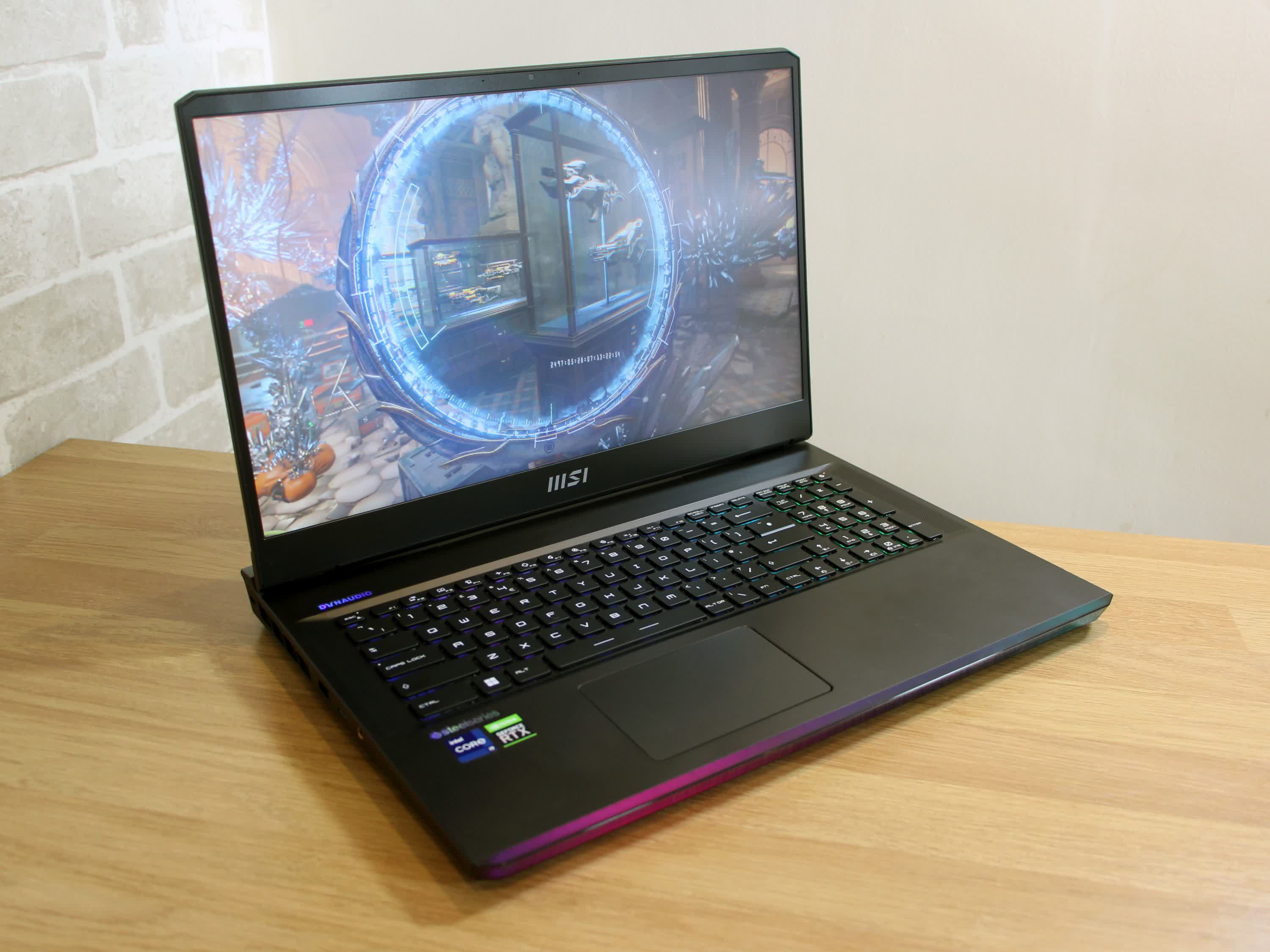
There are downsides, too. The GE77 is thicker and heavier than some of its direct rivals and arguably looks less stylish, too. The screen is good for mainstream gaming, but the Alienware and Razer panels both have better quality and a wider variety of specification options.
It’s worth thinking about whether you really need a laptop like the MSI Raider GE77, too. There’s no doubting its performance, but you won’t need an RTX 3080 Ti unless you want to run the toughest games at top settings. And while the i9-12900HX will brush aside any mobile workload, you can easily get away with a lesser Core i7 or Core i9 CPU for photo and video editing and lots of other work tasks.
If you’re happy to opt for an RTX 3070 Ti or a less extreme processor, you can save loads of cash on different GE77 specifications (a well balanced model goes down to $2,499) or several different Alienware x17 models. If you do need that level of performance, though, there’s nothing like the MSI Raider GE77 – it outpaces rivals at no extra cost when their specifications are aligned.
Shopping Shortcuts:
- MSI Raider GE77 (RTX 3080 Ti / i9-12900HX) at Amazon
- MSI Raider GE77 (RTX 3080 Ti / i7-12800HX) at Amazon
- MSI Raider GE77 (RTX 3070 Ti / i7-12800HX) at Amazon

0 Comments :
Post a Comment